Similarly, are flame retardants safe?
Growing Evidence Says 'No' New studies have underscored the potentially harmful health effects of the most widely used flame retardants, found in everything from baby blankets to carpets. Compounds thought to be off the market due to health concerns continue to be used in the U.S.
Subsequently, question is, what chemicals are in flame retardants? Flame retardants are chemicals that are supposed to slow ignition and prevent fires. They are used to meet flammability regulations. Flame retardants of concern include organohalogen and organophosphate chemicals such as polybrominated diphenyl ethers (PBDEs) and chlorinated tris (TDCPP).
Beside above, do flame retardants cause cancer?
There is growing evidence that many flame retardant chemicals can affect the endocrine, immune, reproductive, and nervous systems. Some animal studies have shown that long-term exposure to flame retardants can lead to cancer.
What are the effects of flame retardants in the body?
- Endocrine and thyroid disruption.
- Impacts to the immune system.
- Reproductive toxicity.
- Cancer.
- Adverse effects on fetal and child development.
- Neurologic function.
Do flame retardants wear off?
Is water a flame retardant?
Why is fire retardant red?
How can you reduce exposure to flame retardants?
- Whenever possible choose PBDE-free electronics and furniture.
- Avoid contact with decaying or crumbling foam that might contain fire retardants.
- Use a high-efficiency particulate air (HEPA) filter vacuum cleaner.
- Replace couches, stuffed chairs, automobile seats and the like that have exposed foam.
Does Ikea furniture have chemicals?
Is Ashley Furniture toxic?
Do all couches have flame retardants?
Are Ikea curtains fire retardant?
When did furniture add flame retardants?
Is fire retardant dropped from planes toxic?
What products contain brominated flame retardants?
Contents in plastics.
| Polymer | Content [%] | Substances |
|---|---|---|
| High impact polystyrene | 11–15 | DecaBDE, brominated polystyrene |
| Epoxy resin | 0-0.1 | TBBPA |
